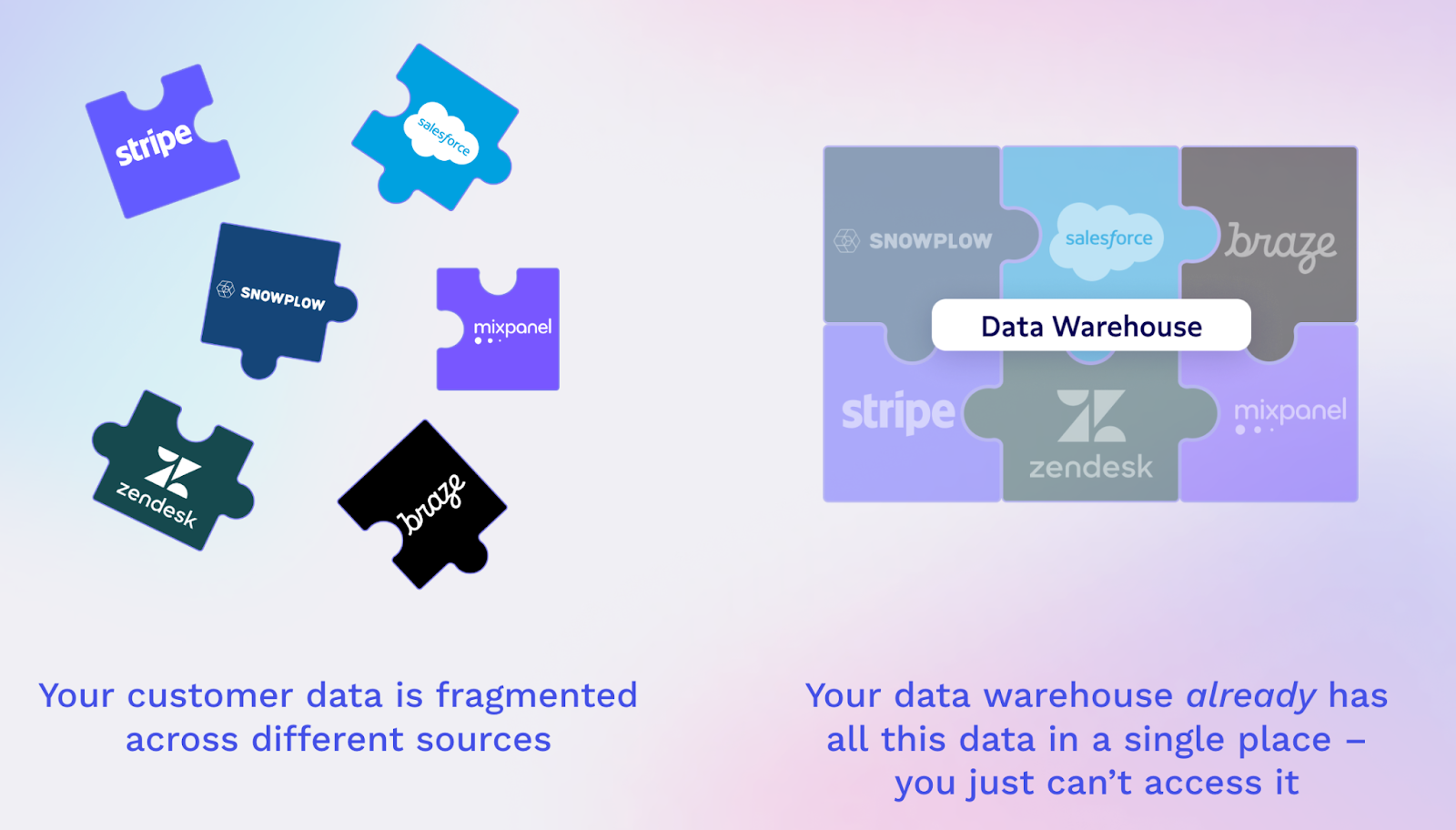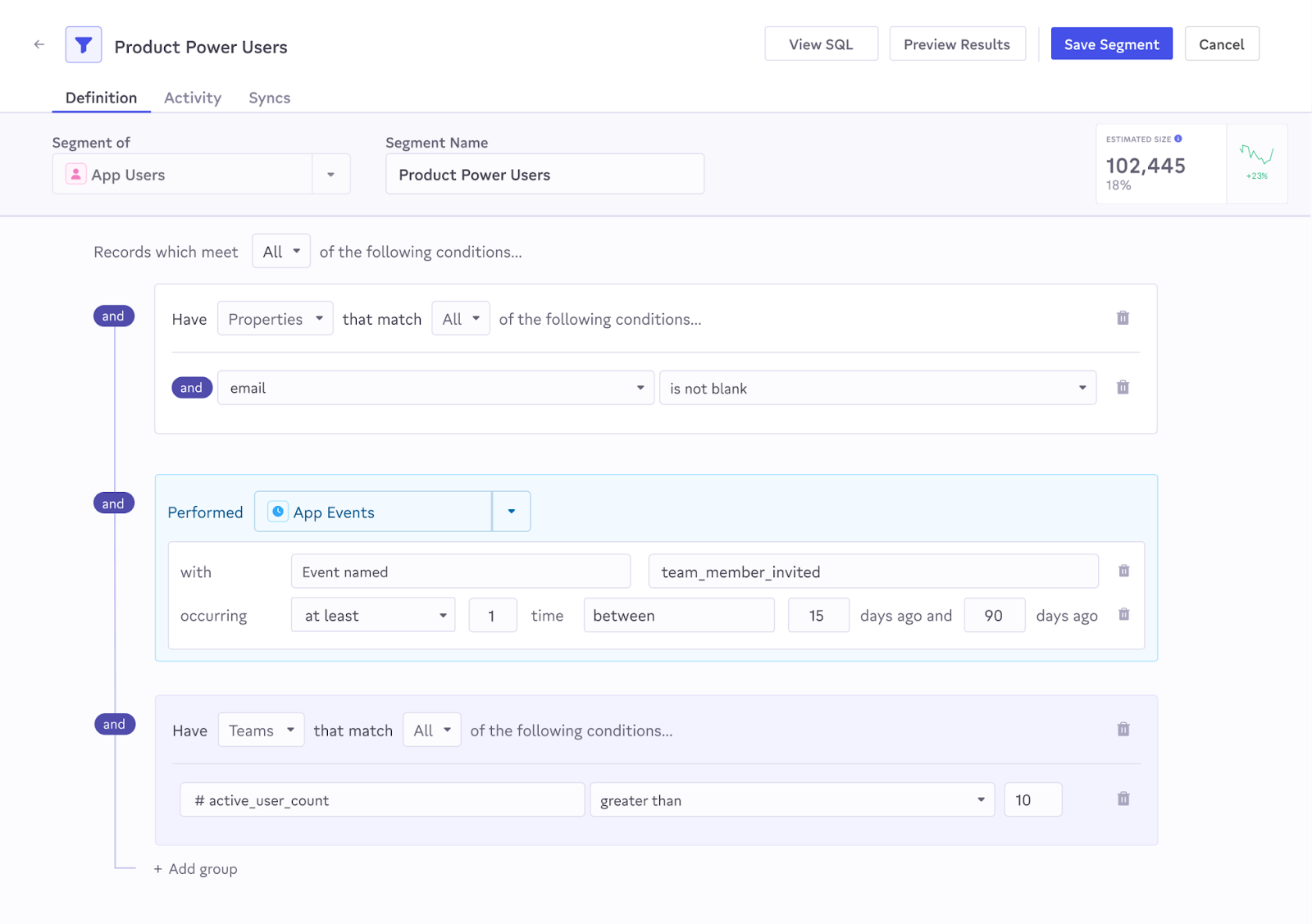As your company grows and your client list expands, so do your growth opportunities. But if you're not targeting the right folks with your messages, you might feel like you're shouting into the void.
Because technically, you are. 🗣️
By neglecting to engage with the segments of your audience whose data lives in an internal database that’s guarded by your data team, you’re leaving all your golden growth opportunities on the table.
In working to generate demand, retain a loyal client base, and act on cross and up-sell opportunities, you’re likely already targeting the usual suspects. 🎯 MQLs, accounts in your target account list, webinar registrants, and event attendees – they’re all likely on your radar. But to level up your marketing campaigns, you have to target more than just the contacts you’re collecting in your CRM.
In this blog, we’ll dive into ✋ key audiences you should be targeting and how you can access the data you need to target them.
Audience #1: Upsells
Generating demand is no longer just about delivering new leads to your sales team. To maximize revenue for your business, you need to focus on the full customer lifecycle, including retention and cross/upsell efforts. That means proactively identifying which segments of your existing customers are ready to upgrade or add on to their subscriptions and serving them the right messaging to ensure they're effectively nurtured when sales conversations kick off.
But here's the 🔑: Instead of bombarding every single customer with upsell messaging, you need to focus on some of the segments that are most likely to upgrade:
- Core plan users — Segment your customers by which users are on which plan so that you can tailor your offers to their specific needs. From here, you can determine which users are on basic plans limiting their ability to adopt the product fully. For example, a single-user plan limits collaborative opportunities and can be the perfect upgrade target when they hit a page that’s gated for multi-user teams. 🚧
- Users approaching usage limits — Keep an eye on the segments of your audience that are close to going over their plan limits, and proactively reach out to fit them with the right plan for their needs. By targeting all users who hit 80% of usage limits, for example, you can drive upsell revenue while helping users ensure continuity of service.
- High NPS score users — These are your power users – the ones who frequently chat with your support team, leave high NPS scores, and refer your product to others. They're also the ones who are likely interested in unlocking more of the valuable features that your product has to offer. 🔐
HOVER uses Census to target their messaging to product-qualified leads (PQLs) and highlight relevant features they can upgrade to. Read their story here.
Audience #2: Win-backs
Customers can churn for various reasons — miscommunication, budgetary constraints, and poor adoption can all lend to a decision not to renew. Just because you don’t get the renewal doesn’t mean you should give up on eventually becoming their vendor of choice. While there are some instances where a relationship may have ended for good, here are some churned segments that could be targeted for a win-back conversation. 👇
- Product adoption churns — Winning back a customer who churned due to low product adoption requires a targeted approach. Did your customer churn due to a lack of understanding? Maybe it was inadequate training or a missing feature. Once you identify the root cause of their lack of adoption, you can tailor a strategy that addresses their specific needs, whether that’s additional training resources or a different product configuration. A personalized approach to addressing specific pain points is your best bet in winning back business and building a lasting relationship.
- Customer satisfaction churns — A good starting point is to thoroughly analyze your customer’s past interactions with your brand, including the service they received and any issues they faced. ⏪ A tangible solution that acknowledges pain points could include a special promotion, a product advisory board invitation, or a tailored onboarding experience to help them get the most out of your product. The major key? Address the reasons for dissatisfaction head-on and offer a compelling solution to entice their return.
- Feature-related churns — The downside is obvious when a customer churns for lack of feature availability. The upside: Once you’ve built those features out, you have the opportunity to showcase how their feedback has been incorporated into your product. It’s important to keep track of different features that may be causing your customers to churn. Once you’ve identified the problem, it can give your product team a better understanding of what roadmap items to prioritize. And down the road, once that feature has been implemented, being able to share resources like product update newsletters or down-funnel webinars demoing new features can increase your odds of winning their business back. 🏆
Audience #3: Trial users
Trials can be a vital opportunity to showcase the power of your product to prospective customers. But did you know that over 75% of B2B trial users don’t convert to paid users? When a trial user doesn’t convert to a paid user, that doesn’t mean it’s time to mark them closed-lost. Instead, create personalized journeys to ease the following audiences back into a sales conversation when they’re ready to buy:
- Trial ended but not ready to purchase — There are several reasons that a user might not be prepared to buy your product after their trial ends. Anything from budgetary constraints to evaluating competing solutions can put a hold on a decision to convert to a full user of your product. It's crucial to keep these users engaged with personalized content to remind them of your product's benefits and stay top of mind. Consider offering additional resources like white papers, blog content, or a follow-up trial to help them further understand the value of your product.
- Trial ongoing — For users still in the middle of their trial, it's essential to provide the necessary support and resources to ensure they get the most out of your product and see it as a must-have once the trial has concluded. Offer them personalized training and support to help them see the total value of your product to ensure that they’re sold on both the product’s abilities and the quality of your support team.
- Have not yet seen a trial — These users either aren’t familiar with your product yet, or aren’t interested in seeing it in action yet. Either way, it's essential to create targeted content that showcases the value of your product and encourages them to start a trial. This allows them to experience the benefits of your product firsthand and can increase the likelihood of them converting to paid users.
Audience #4: Highly Engaged Users
A marketer must balance efforts between acquiring new logos and building a strong brand. 💪 While it's crucial to identify and overcome any potential obstacles that could hinder revenue growth, it's equally important to tap into the segments of your audience that can help drive it. These highly engaged users are your most passionate advocates, eagerly anticipating every product enhancement and new release. To effectively leverage this group, you should focus on nurturing and developing relationships with the following segments:
- Early adopters — These are the first users who have tried your product or service and are excited to explore its capabilities. They often offer valuable feedback and insights that can help shape the direction of your product roadmap. 🗺️ By engaging with this group and incorporating their feedback, you can build a stronger product that meets the needs of your target market.
- Power users — These are your most engaged and dedicated users who utilize every feature your engineering team has built. They have a deep understanding of your product's value propositions and can explain them better than your own account executives can. By providing them with additional resources and support, you can nurture this group into becoming advocates for your brand.
- Advocates — These are the users who are willing to speak on your behalf, participate in webinars, represent your organization at conferences, and even engage in online discussions to express their love for your product. By cultivating strong relationships with your advocates, you can amplify your brand's reach and drive growth through their advocacy. 🪴
By recognizing and leveraging these highly engaged user segments, you can drive significant brand growth while building long-lasting relationships with your most passionate customers.
Audience #5: Churn risks
Generating demand and driving new leads for the sales team is crucial, but it's equally essential to identify churn risks and address pain points to provide an improved customer experience. To effectively identify these risks, there are several key metrics to keep an eye out for:
- Users in the bottom 25% of MTD logins — The frequency with which your customers log in to use your product strongly indicates their likelihood to churn. By tracking customers who haven't logged in for a set period, you can proactively identify and re-engage customers who may be at risk of churn. This allows you to tailor your marketing programming and customer success efforts to their specific needs and pain points, helping to retain their business.
- Users giving low NPS scores — Net Promoter Score (NPS) is a measure of customer loyalty and satisfaction. Customers who consistently give low NPS scores are your highest churn risks, so monitoring this metric closely is important. By identifying customers with low NPS scores, you can address their pain points and work to improve their experience with your product or service.
- Users opening the most support tickets — A high volume of support tickets can indicate that customers are struggling with your product or service. By tracking this metric, you can identify pain points and take steps to address them. This may involve improving product documentation, providing additional training resources, or making product enhancements to address common issues.
Monitoring these metrics and proactively addressing churn risks can improve customer retention and create a more positive customer experience. This helps retain existing customers and can also lead to positive word-of-mouth referrals and increased demand for your product or service.
Putting Your Data to Work

|
You’re collecting a lot of first-party data on your customers and prospects, but are you using it to help drive revenue for your business? With so many different parts of your tech stack and data being pulled in through so many different sources, it’s hard to get a true 360° view of your customers. Here’s the good news: That 360° view does exist and chances are your data team is already paying to store it in the data warehouse.
You might be thinking,
“I have no idea how to write SQL!”
or
“How am I supposed to comb through all that data?!”
Warehouse-native data activation tools like Census help bridge the gap between data teams and marketing teams so that you can enjoy all the benefits of the data warehouse without ever having to write a single line of code.

|
Your data team can build a set of trusted models that you, as a marketer, can then use to sync customer attributes or combine to build segments of users to target with personalized content. The end result? Your data team isn’t overwhelmed by data requests, and you’re using all your MarTech investments to their fullest potential.
Marketers have no shortage of campaign ideas, but siloed data makes it difficult to take these campaigns from ideation to execution. With data activation, you no longer have to let your dreams be dreams (and, as a bonus, you don’t have to learn how to code). 😮💨 You just have to find a friend on the data team to help build the models that you need.

|
🚀 If you’d like to learn more about how Census works with marketing teams to activate data trapped in the data warehouse, book a demo with one of our product specialists.


















